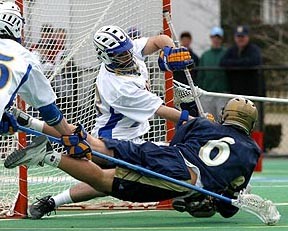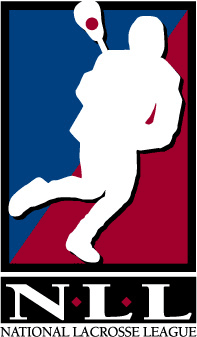 |
 |
||
Box LacrosseThe Differences Between Indoor and Outdoor LacrosseThere are several differences between box lacrosse and outdoor lacrosse. Those who have seen a game of outdoor lacrosse would probably see the indoor version as a completely different game. Generally speaking, indoor lacrosse is much rougher, and a lot more "hack-and-whack." There are two different reasons as to why indoor lacrosse is much more physical than outdoor:
Another difference between the two types of lacrosse is the goalie pads. The goalie pads for outdoor lacrosse are almost non-existant. They only wear gloves, chest protector, helmet and throat guard. The indoor lacrosse goalie pads could rival the biggest hockey pads. They wear: Gloves, helmet, shoulder pads, chest protector, leg pads, and sometimes thigh pads. It is a wonder they can even walk in those things, not to mention save a goal! The third difference is the size of the goal. Outdoor lacrosse goals are six feet wide and six feet tall. Indoor lacrosse goals are four feet wide and four feet tall.  The National Lacrosse League (known as the NLL) was founded in 1986, and as 14 teams throughout North America.
Box LacrosseNow you are probably thinking, "Wait. Box lacrosse goalies have HUGE pads and a smaller goal? What's going on?" This is true, but you must also remember that the playing field in much smaller, so there are a lot more scoring chances. The number of players on a field is also a difference. Indoor lacrosse rules state that only six people, including the goalie, can be on the field from each team. This is contrary to outdoor lacrosse, in which ten are allowed on the field from each team. Most box lacrosse games have a 30 second shot clock. The only outdoor lacrosse league to incorporate a shot clock is the MLL, Major League Lacrosse. Another difference is that Indoor lacrosse does not have more than one size of a stick. They only play with short sticks. In outdoor lacrosse, every defender has a long-pole. The box lacrosse field is way to small to have certain players with a long-pole. The only other major difference between the two types of lacrosse is the switching hands. Almost all indoor lacrosse players will keep the ball in their dominate hand, and not switch for the whole game. They do this because:
Most of the other differences are minor enough to not effect your lacrosse playing ability.
 The National Lacrosse League (known as the NLL) was founded in 1986, and as 14 teams throughout North America.
The National Lacrosse LeagueOriginally known as the MILL (Major Indoor Lacrosse League),the NLL has been met with much adversity, and is constantly dropping and adding teams. This should change soon, as the current commissioner promises to expand the league into 20 teams by 2011. It currently has about 292 players, 73% of whom are Canadian. Regular season games begin in the winter, and are always held on the weekends. Because the NLL has one of the worst paying salaries for any sport, most players have other full-time jobs. The National Lacrosse League has endure plenty of hardships, but it will surely grow and prosper in the near future. | |||
Find a topic...
|
|||
|
Homepage | Contact Me | Sitemap | Privacy Policy
Buy Equipment | How to Play | History | Coaching | Drills | Plays | Equipment | Famous Players | Hits Positions | Recruiting | Tricks
Copyright©
2008-2016 Lacrosse-Information.com. No reproduction of material without express written permission of the webmaster. | Google
|
|||